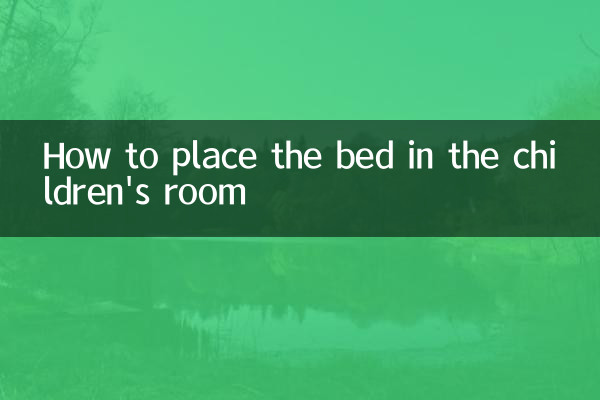How to place the bed in the children's room? Scientific layout helps children grow up healthily
In recent years, the decoration and layout of children's rooms have become a hot topic for parents to pay attention to. With the popularization of scientific parenting concepts, how to create a safe, comfortable and meet the needs of growth for children has become the focus of discussions among many families. This article will combine popular topics and practical suggestions in the past 10 days to provide parents with detailed guides on the placement of beds in children's rooms.
1. Four principles for placing beds in children's room

1.Safety priority: Avoid placing the bed close to windows or sharp furniture to prevent children from climbing or bumping. 2.Lighting and ventilation: The bed should be placed to ensure sufficient natural light, and avoid direct air conditioner blowing or air outlet position. 3.Psychological comfort: According to children's psychology, the bed should be placed against the wall to give children a sense of security. 4.Space Utilization: Plan the activity area and sleeping area reasonably to avoid crowding.
2. Comparison of popular bed placement plans
| Placement method | advantage | shortcoming | Applicable scenarios |
|---|---|---|---|
| Place against the wall | Save space and enhance the sense of security | May affect ventilation | Small apartment or children's room |
| Place in the center | Flexible activity space, beautiful and elegant | Large area occupied | Large apartment or school-age children's room |
| High and low bed combination | Save space and is very interesting | There is a risk of falling | Second-child family or loft house |
3. Practical suggestions in hot topics within 10 days
1.Avoid electrical interference: Recent hot searches show that many parents are concerned about the impact of electronic devices on sleep, and it is recommended that the bed be kept at a distance of more than 1.5 meters from the desk and TV. 2.Color psychology application: The "Morandi color system" hotly discussed on social platforms can reduce children's anxiety, and it is advisable to choose soft tones for bedding. 3.Seasonal adjustment: In summer, the bed should be away from the walls of the west and close to the sun-lit area in winter.
4. Expert suggestions and Feng Shui tips
1.Growth adaptability: Pediatricians recommend that the height of preschool children should not exceed 40cm, and primary school students can increase the height appropriately. 2.Traditional Feng Shui: There should not be a beam at the top of the bed to avoid the saying of "pressing the top"; if the door faces the end of the bed, a screen or curtain can be added to resolve the problem. 3.Environmentally friendly materials: The recent "formaldehyde exceeds the standard" incident reminds parents that choosing solid wood bed frames is safer than composite boards.
5. Case reference and data statistics
| Family Type | Preferred bed type | Average budget (yuan) | Top 3 concerns |
|---|---|---|---|
| New parents born in the 90s | Variable splicing bed | 2000-3500 | Environmentally friendly, beautiful, multi-functional |
| Second-child family | L-shaped high and low bed | 5000-8000 | Safety, storage space, durability |
| Small school district housing | Tatami one-piece bed | 3000-6000 | Space utilization, cost performance, comfort |
Conclusion:The placement of beds in children's rooms is not only related to the aesthetics of the space, but also closely related to the healthy development of children. It is recommended that parents flexibly adjust their children's age, personality characteristics and actual room conditions, and regularly communicate with their children's experience to create a truly suitable growth space.

check the details

check the details